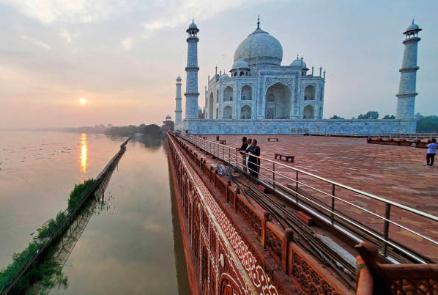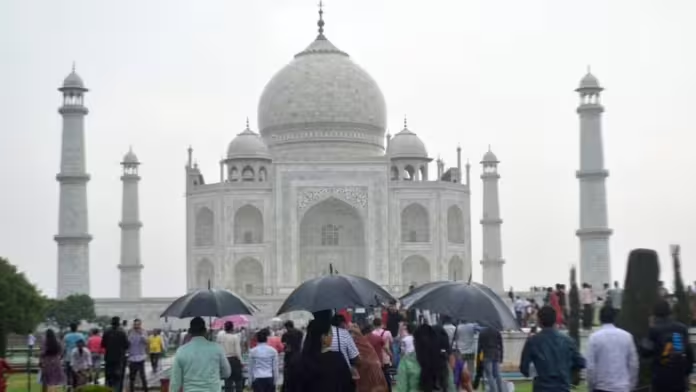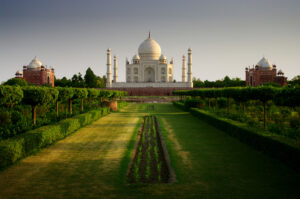SC refuses tree cutting around Taj Mahal, stalls proposed industrial hub in Agra
The Supreme Court on Tuesday denied a request to cut over 4,000 trees around Taj Mahal in Agra for Uttar Pradesh government’s manufacturing hub project. The court said that Agra isn’t short of industries but it’s short of trees. “We cannot appreciate cutting of so many trees in Taj Trapezium Zone and that too for a non-specified purpose,” it added.

On Tuesday, the Supreme Court issued a denial of the request to cut down more than 4000 trees in Agra for the purpose of establishing a manufacturing hub project proposed by the state government. The court’s decision carries significant weight, as it underscores the importance of preserving Agra’s natural environment and highlights the need to safeguard the surroundings of the iconic Taj Mahal.
In its ruling, the Supreme Court emphasized a crucial point – that Agra is not lacking in industries, but it is indeed facing a shortage of trees. This assertion reflects a commitment to prioritizing environmental conservation and sustainable development over unchecked industrial expansion. The court’s decision sends a clear message that environmental considerations hold a paramount place in the region’s developmental plans.
The denial of the request to fell trees for the manufacturing hub project signifies a balanced approach that seeks to strike a harmonious equilibrium between economic growth and ecological preservation. The Supreme Court’s decision acknowledges the significance of maintaining the green cover in Agra, which is vital for the well-being of both the local ecosystem and the millions of visitors who come to admire the timeless beauty of the Taj Mahal.
By choosing to protect the trees and environment in Agra, the Supreme Court has underscored the need for responsible and sustainable development strategies. The ruling aligns with global efforts to promote conservation, combat deforestation, and mitigate the adverse impacts of industrialization on natural habitats. In doing so, the court’s decision reflects a progressive stance that places the long-term health of the environment at the forefront of decision-making.
Furthermore, the ruling serves as a precedent for future projects, emphasizing the importance of conducting thorough environmental impact assessments and considering the preservation of natural resources before initiating large-scale developmental initiatives. It encourages a holistic approach that takes into account the complex interplay between economic growth, environmental sustainability, and cultural heritage.
The Supreme Court’s decision resonates with the sentiment that protecting Agra’s trees is a vital step towards safeguarding the region’s ecological balance and maintaining its unique identity. By recognizing that Agra’s true wealth lies not just in industrial ventures, but also in its natural assets, the court has demonstrated a commitment to nurturing a harmonious coexistence between human progress and the environment.
The court’s ruling also aligns with the broader global movement towards sustainable development, which seeks to balance economic prosperity with ecological stewardship. It emphasizes that economic growth should not come at the expense of environmental degradation, and instead advocates for responsible and conscientious approaches that prioritize the well-being of both present and future generations.
In conclusion, the Supreme Court’s denial of the request to fell trees for the manufacturing hub project in Agra sends a powerful message about the importance of environmental preservation and sustainable development. The decision not only safeguards Agra’s natural heritage but also upholds the timeless legacy of the Taj Mahal, a symbol of India’s rich cultural heritage. It sets a precedent for responsible decision-making and underscores the need for a holistic approach that places the environment at the heart of developmental plans.
The recent pronouncement by the Supreme Court highlighted a significant observation – Agra’s scarcity does not lie in industries; rather, it pertains to a shortage of trees. The bench comprising justices Sanjay Kishan Kaul and Sudhanshu Dhulia underscored this perspective, reaffirming the court’s commitment to safeguarding the environment around the revered Taj Mahal. The court expressed its concern over the proposal to fell a substantial number of trees within the Taj Trapezium Zone (TTZ) for a purpose that lacked clear specification.
The Supreme Court’s statement encapsulates a profound understanding of the delicate balance between economic development and ecological conservation. By asserting that Agra possesses an ample industrial presence but is deficient in its tree cover, the court underscores the value of nurturing the natural environment. This sentiment aligns with the global shift towards recognizing the irreplaceable benefits that trees and green spaces offer to ecosystems, communities, and cultural landmarks.
The court’s reference to its prior interventions in safeguarding the environment around the Taj Mahal is a testament to its ongoing commitment to preserving the iconic monument’s surroundings. The Taj Trapezium Zone, an ecologically sensitive area, holds immense significance in maintaining the integrity and aesthetics of the Taj Mahal. The court’s vigilance in this regard reflects its recognition of the broader context within which developmental decisions must be made.
Furthermore, the court’s expression of reservation regarding the felling of a substantial number of trees in the TTZ for an unspecified purpose highlights a principled stance on transparency and accountability in developmental projects. The absence of a clear and well-defined objective raises concerns about the potential impact on the local environment and community. The court’s insistence on a specific purpose underscores the importance of comprehensive planning and consideration of the potential consequences of such actions.
In conclusion, the Supreme Court’s observation that Agra’s scarcity lies not in industries but in trees encapsulates a profound understanding of the delicate balance between economic progress and environmental preservation. The court’s commitment to protecting the Taj Mahal’s surroundings and its emphasis on transparency and specificity in developmental projects exemplify its role as a guardian of both cultural heritage and natural ecosystems. This stance resonates with the global imperative to prioritize sustainable development and underscores the importance of responsible decision-making that respects the intricate interplay between human progress and the environment.
The Uttar Pradesh State Industrial Development Authority (UPSIDA) had submitted an application to the Court, seeking permission to fell a total of 4,087 trees. The purpose behind this request was to pave the way for the establishment of an integrated manufacturing cluster (IMC) in the city of Agra.
The chosen site for this proposed IMC holds strategic significance due to its advantageous placement. Situated along the Yamuna Expressway and the National Highway NH-19, the location offers convenient access to major transportation routes. Additionally, its proximity to the dedicated freight corridor at Tundla further enhances its attractiveness as a potential hub for industrial development.
The UPSIDA’s proposal to create an integrated manufacturing cluster aligns with broader efforts to stimulate economic growth and industrialization in the region. Such clusters are designed to foster synergies between various industries and encourage collaboration, innovation, and efficiency. However, the proposed felling of a significant number of trees for this purpose has raised environmental concerns and prompted the scrutiny of the Supreme Court.
The Court’s consideration of the UPSIDA’s application takes into account not only the potential economic benefits of the IMC but also the ecological impact of tree removal in the designated area. The court’s cautious approach reflects its commitment to upholding a balanced and sustainable approach to development, where economic progress is pursued while safeguarding the environment and the well-being of local communities.
In evaluating the UPSIDA’s request, the Supreme Court’s decision is rooted in a broader context that encompasses both the immediate developmental goals and the long-term environmental implications. This balanced perspective exemplifies the court’s role as a guardian of both economic interests and ecological preservation, ensuring that the pursuit of growth is aligned with the principles of responsible and sustainable development.
The matter was brought before the highest court in the context of its ongoing oversight in the MC Mehta case, which pertains to the preservation of the Taj Mahal and the surrounding environment.
The Supreme Court has taken a proactive stance in safeguarding the iconic Taj Mahal and its environs. As part of its regulatory framework, the Court has stipulated that any tree felling within the designated zone around the Taj Mahal, known as the Taj Trapezium Zone (TTZ), requires explicit permission from the court itself.
This decision stems from the Court’s recognition of the unique and irreplaceable cultural and environmental significance of the Taj Mahal, a UNESCO World Heritage Site. The TTZ encompasses a region of critical importance for the protection of the monument and its immediate surroundings. In order to maintain the delicate ecological balance and prevent any adverse impact on the heritage site, the Supreme Court has mandated strict oversight and control over activities within this zone, including tree removal.
The Court’s intervention in granting or denying permission for tree felling underscores its commitment to maintaining the ecological integrity of the Taj Mahal and the surrounding area. This approach aligns with the broader objectives of sustainable development and responsible environmental management, ensuring that any alterations or developments within the vicinity of the Taj Mahal are conducted in a manner that preserves its cultural and natural heritage.
By taking up the UPSIDA’s application in the MC Mehta case, the Supreme Court is fulfilling its role as a vigilant guardian of India’s rich cultural heritage and environmental well-being. The Court’s insistence on a case-by-case assessment for tree removal within the TTZ demonstrates its dedication to upholding the sanctity of the Taj Mahal and the imperative of protecting it for future generations.
The Supreme Court had established a clear mandate that obtaining its permission is imperative for any tree-cutting activities within the designated zone surrounding the Taj Mahal, known as the Taj Trapezium Zone (TTZ).
The state department, through its application, provided insights into the proposed Integrated Manufacturing Cluster (IMC) project in Agra. This venture is slated to be executed through a specialized entity referred to as a special purpose vehicle (SPV), which involves collaborative efforts between the Uttar Pradesh State Industrial Development Authority (UPSIDA) and the Central government.
The concept of a special purpose vehicle represents a focused and dedicated approach to carrying out specific projects. In this case, the SPV acts as a framework through which the UPSIDA and the Central government collaborate to oversee and facilitate the implementation of the IMC Agra project. This joint effort aims to leverage the expertise, resources, and strategic vision of both entities to ensure the successful execution of the project.
By establishing an SPV for the IMC Agra project, the state department seeks to optimize coordination, streamline decision-making processes, and allocate resources efficiently. This approach reflects a deliberate strategy to harness synergies between different stakeholders and ensure that the project’s objectives are met effectively.
The involvement of the Central government in this collaborative effort underscores the significance of the IMC Agra project on a broader scale. This joint venture emphasizes the commitment to driving economic growth, development, and job creation in the region, while also aligning with the principles of sustainable development and responsible environmental stewardship.
As the application for tree cutting was presented in the context of the TTZ, the Supreme Court’s mandate regarding the necessity of its permission for such activities remains a central consideration. The Court’s involvement in reviewing and granting approval for tree removal underscores its role as a safeguard for the environment and cultural heritage, ensuring that any modifications within the vicinity of the Taj Mahal are undertaken with utmost care and adherence to established regulations.
In sum, the proposed IMC Agra project, facilitated through a special purpose vehicle in collaboration with the UPSIDA and the Central government, reflects a strategic and coordinated approach to regional development. This approach underscores the commitment to sustainable growth while upholding the vital importance of preserving the ecological and cultural integrity of the Taj Trapezium Zone.
The envisaged project holds the potential to yield a substantial socioeconomic impact, with an estimated projection of around 37,000 direct employment opportunities across the selected sectors as determined by demand assessment. This, in turn, implies that the ripple effect of this endeavor could potentially lead to the creation of approximately 22,000 additional jobs indirectly. In aggregate, the Integrated Manufacturing Cluster (IMC) has the capacity to engender a cumulative employment opportunity of around 70,000 positions.
The implications of this projected employment surge are far-reaching and have the potential to usher in a transformative era for the skilled and semi-skilled workforce prevalent in the vicinity of Agra. The anticipated influx of jobs spanning various skill levels and sectors is poised to provide a significant impetus to the local labor market, contributing to economic growth, improved livelihoods, and enhanced socioeconomic prospects for individuals and families residing in the region.
By capitalizing on the rich pool of skilled and semi-skilled labor available in and around Agra, the IMC project demonstrates its potential not only to foster economic advancement but also to nurture human capital development. The diverse employment opportunities anticipated from this initiative encompass a spectrum of sectors, further enhancing the appeal of the IMC as a robust engine of job creation and economic dynamism.
Moreover, the synergistic effects of direct and indirect employment generation underscore the comprehensive nature of the IMC’s contribution to the local ecosystem. The interplay between these employment tiers showcases the project’s ability to catalyze economic interdependencies, stimulate demand across sectors, and engender a virtuous cycle of growth that extends beyond immediate job placements.
The application’s assertion of the potential for significant employment gains resonates with the broader goals of sustainable development, inclusive prosperity, and regional empowerment. It underscores the strategic significance of the IMC not only as a conduit for industrial expansion but also as a catalyst for elevating the quality of life and socioeconomic well-being of the community it serves.
As the state department advances its proposal and seeks approval for tree cutting as part of the IMC Agra project, the multifaceted benefits, including substantial employment generation, remain integral to the project’s vision and its potential to shape a brighter and more promising future for Agra and its inhabitants. The confluence of economic growth, job creation, and environmental considerations underscores the complex tapestry of factors that must be carefully balanced and harmonized to ensure a sustainable and prosperous trajectory for the region.
The bench emphatically expressed its stance, affirming that the scarcity in Agra lies not in the domain of industries, but rather in the realm of trees. A crucial facet of the project appears to be unfolding on land that holds forest attributes.
The amicus curiae appointed by the Court, the esteemed senior advocate ADN Rao, brought to the Court’s attention critical aspects of the project. He delineated that the project’s expanse is envisioned across a sprawling area measuring 1058 acres, situated in the locale of Rahan Kalan within the Etmadpur tehsil of Agra.

Moreover, the distinguished amicus curiae apprised the Court of the proactive measures taken by the applicant authority in the pursuit of ecological balance. Specifically, he underscored that the said authority has procured the requisite endorsement from the state government to undertake compensatory afforestation as a mitigation strategy. This strategy entails the planting of a noteworthy 10 saplings for each tree that is slated for felling.
In a testament to the conscientious approach adopted, the state administration has designated non-forest land within the same village for the purpose of planting a substantial 40,870 saplings. This proactive step aims to foster an ecosystem of ecological rejuvenation and counterbalance, serving to mitigate the environmental impact engendered by the proposed tree cutting for the envisaged project.
The amicus curiae’s elucidation of these pivotal components underscores the comprehensive approach being taken to harmonize developmental pursuits with ecological preservation. The Court’s consideration of these aspects holds significance in determining the holistic implications of the project and ensuring a balanced approach that safeguards environmental equilibrium while accommodating developmental imperatives.
As the proceedings unfold and deliberations continue, these facets exemplify the intricate tapestry of considerations that intertwine to shape decisions of profound import, impacting both the immediate landscape and the broader environmental context. The proactive initiatives, in tandem with the Court’s vigilance, illustrate a concerted effort to strike a judicious balance between progress and ecological conservation, ultimately contributing to the sustainable advancement of the region.
Nevertheless, the Court found itself unconvinced by the proposition of compensatory afforestation through saplings, recognizing the inherent time lag that saplings would entail to mature into fully grown trees. This temporal delay, in the Court’s view, posed a significant challenge to the immediate need for preserving the existing ecosystem.

The bench’s discerning observation extended further, delving into the core purpose for which the trees were sought to be felled. In this regard, the Court astutely noted that the intended objective of tree clearance was to pave the way for the establishment of a manufacturing complex. However, this pursuit of industrial development was deemed to be incongruent with the principle of safeguarding the environment within the area.
The Court’s rationale hinged on the recognition of the potential adverse repercussions that the manufacturing complex could pose to the local environment. The manufacturing hub, while offering prospects for economic advancement, was deemed to carry with it the risk of ecological degradation. Such an outcome could undermine the very essence of environmental preservation that the Court has steadfastly sought to uphold, particularly in the vicinity of the iconic Taj Mahal.
By deftly intertwining considerations of temporal efficacy and environmental impact, the Court displayed its astute commitment to a comprehensive evaluation of the matter at hand. The deliberative process highlighted the necessity of striking a delicate equilibrium between developmental aspirations and ecological integrity, with a clear emphasis on ensuring that the latter does not fall victim to the exigencies of the former.
The Court’s nuanced approach underscores its unwavering dedication to fulfilling its custodial role as a guardian of both the cultural heritage and natural heritage that define the region’s identity.
In a sequence of administrative actions, the Uttar Pradesh State Industrial Development Authority (UPSIDA) initiated the process that ultimately led to the submission of the application before the Supreme Court. This procedural trajectory commenced in December, when UPSIDA formally presented its application before the apex court, seeking permission for the felling of over 4000 trees as an essential step towards its proposed project.
Concurrently, UPSIDA pursued a parallel path by forwarding a proposal to the State Level Environment Impact Assessment Authority (SEIAA) located in Lucknow. The objective of this parallel engagement was to initiate the preparation of an Environment Impact Assessment (EIA) report for the envisaged project. This comprehensive report would serve as a pivotal document for gauging the potential environmental consequences of the undertaking.

The collaborative efforts between UPSIDA and SEIAA culminated in a significant milestone. By May of 2022, the SEIAA issued standardized terms of reference, signifying a crucial step in the procedural journey towards securing the necessary environmental clearance for the project. These terms of reference delineated the parameters and guidelines that would guide the comprehensive evaluation of the project’s environmental impact.
Subsequently, in a development indicative of the project’s progressing trajectory, the state government weighed in with its endorsement. In September, the state government granted its formal sanction for the project, allocating a budgeted amount of ₹332 lakhs to cover the anticipated costs associated with the felling of 4087 trees.
However, the state’s commitment went beyond the act of tree clearance, encompassing a strategic vision for ecological restoration. As part of this vision, a substantial number of 40,870 saplings were earmarked for planting, accompanied by a meticulous plan for their maintenance over a ten-year span.
The state’s calculated approach, involving both the removal of trees and the subsequent afforestation initiatives, appeared to be an attempt to strike a delicate equilibrium between industrial expansion and environmental preservation. However, the subsequent legal deliberations brought to the fore the nuanced challenges of achieving such a balance, particularly within a context marked by the iconic presence of the Taj Mahal and the imperative to safeguard its surroundings.
As the legal proceedings unfolded, the Supreme Court’s careful consideration of the intricacies surrounding the tree-felling proposal underscored the need for an equilibrium that extends beyond mere numerical compensation.
The Court’s skepticism regarding the long-term efficacy of sapling afforestation and its astute analysis of the project’s environmental impact emerged as emblematic of its role in ensuring a judicious interplay between developmental aspirations and ecological prudence. The delicate interplay between policy initiatives, administrative actions, and judicial evaluation elucidated the complexities inherent in the pursuit of holistic and sustainable growth.


